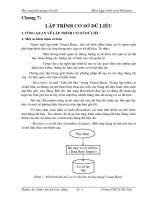Bài giảng Cơ sở dữ liệu nâng cao Chapter 2 Disaster recovery
Bạn đang xem bản rút gọn của tài liệu. Xem và tải ngay bản đầy đủ của tài liệu tại đây (225.28 KB, 18 trang )
Chapter 2
Disaster Recovery
Agenda
• Recovery technique
• Disaster recovery planning
Overview about database backup and recovery
• Data is a critical asset for an organization to maintain
information about its customers, inventory, purchases,
financials, and products.
• A variety of failures can bring down your database.
Anything from a user error to a natural disaster could take
your database offline. Your backup and recovery plan
needs to account for the possibility of these failures and
more.
Overview about database backup and recovery
• Types of failure:
• Media failure.
• User errors, for example, dropping a table by
mistake.
• Hardware failures, for example, a damaged
disk drive or permanent loss of a server.
• Natural disasters.
Overview about database backup and recovery
• The purpose of creating SQL Server backups is
to enable you to recover a damaged database.
• A well-designed backup and restore strategy
maximizes data availability and minimizes data
loss, while considering your particular business
requirements.
Backup & restore strategy
• The backup strategy defines:
• The type and frequency of backups
• The nature and speed of the hardware that is required for them
• How backups are to be tested
• Where and how backup media is to be stored (including security
considerations)
Backup & restore strategy
• The restore strategy defines:
• Who is responsible for performing restores
• How restores should be performed to meet the goals
• for availability of the database
• for minimizing data loss
• Designing an effective backup and restore strategy
requires careful planning, implementation, and testing
Backup method
• Database Engine provides four different
backup methods:
• Full database backup
• Diferential backup
• Transaction log backup
• File (or filegroup) backup
Backup method
• Full database backup:
• Capture the state of the database at the time the
backup is started.
• During the full database backup, the system copies
the data, the schema of all tables of the database
and the corresponding file structures.
• Even all uncommitted transactions in the
transaction log are written to the backup media.
Backup method
• Differential Backup
• Create a copy of only the parts of the database that
have changed since the last full database backup.
• The advantage of a differential backup is speed. It
minimizes the time required to back up a database.
Backup method
• Transaction Log Backup:
• Consider only the changes recorded in the log. This
form of backup is therefore not based on physical
parts (pages) of the database, but rather on logical
operations - that is, changes executed using the
DML statements INSERT, UPDATE, and DELETE.
Again, because the amount of data is smaller, this
process can be performed significantly quicker than
a full database backup and quicker than a
differential backup.
Backup method
• File or Filegroup Backup:
• Back up specific database files (or filegroups) instead of
the entire database.
• Individual files (or filegroups) can be restored from a
database backup, allowing recovery from a failure that
affects only a small subset of the database files.
• You can use either a database backup or a filegroup
backup to restore individual files or filegroups. This means
that you can use database and transaction log backups as
your backup procedure and still be able to restore
individual files (or filegroups) from the database backup
Recovery model
• Designed to control transaction log maintenance
• Every recovery model lets you back up a whole or partial
SQL Server database or individual files or filegroups of the
database. Table-level backups cannot be created.
• SQL Server has three possible recovery models:
• Simple
• Full
• Bulk Logged
• However, only Simple and Full recovery models are meant
for regular use. Bulk Logged,is designed to be an adjunct to
the Full recovery model.
Recovery model
• Simple Recovery model
• Minimize administrative overhead for the transaction
log, because the transaction log is not backed up
• Data is recoverable only to the most recent backup of
the lost data
Recovery model
• Full Recovery model
• All activities that affect the database are logged in the transaction
log.
• The advantage of this full logging is that every transaction can be
recovered in the event of a failure.
Recovery model
• Bulk log recovery model
• Log most bulk operations.
• For certain large-scale bulk operations such as bulk import or index
creation, switching temporarily to the bulk-logged recovery model
increases performance and reduces log space consumption.
Backup Types
• The scope of a backup of data (a data backup) can be a
whole database, a partial database, or a set of files or
filegroups.
• SQL Server supports 3 backup types:
• Full backup
• Differential backup
• Transaction log backup
Backup Types
• Full backup:
• Contain all the data in a specific database or set of filegroups or
files, and also enough log to allow for recovering that data.
• Differential backup:
• based on the latest full backup of the data.
• Contain only the data that has changed since the differential base.
• Transaction log backup:
• In Full or Bulk-Logged recovery models









